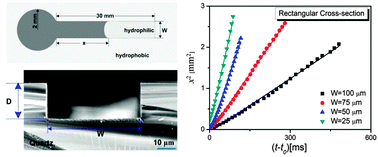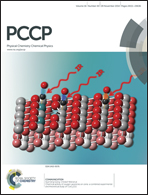Dynamics of capillary-driven liquid–liquid displacement in open microchannels
Abstract
The dynamics of the spontaneous spreading of a liquid droplet along an open hydrophilic microchannel filled with another immiscible liquid is primarily determined by the competition between the capillary driving force and the viscous drag. While the former force depends on the channel cross-section and dimensions, interfacial tension between two liquids and the contact angle formed between the channel's wall and the two liquids, the latter arises from the motion of fluid molecules in the two bulk liquids. This paper focuses on the influence of the outer (displaced) phase viscosity. In general, as the viscosity of the displaced phase increases relative to the viscosity of the displacing phase, the velocity of the liquid–liquid meniscus decreases. The experiments were interpreted by extending a previously established correlation for liquid–vapour systems (J. Phys. Chem. C, 2011, 115(38), 18761–18769) in open microchannels of the same geometry. The relationship between the liquid–liquid flow dynamics and the properties of the liquids (e.g. viscosities) is still unclear. Nonetheless, by taking a self-consistent empirical approach to estimate the influence of the viscosities on the flow kinetics for a given system, it is possible to obtain a reasonable theoretical description for the experimental system over a specific range of viscosity ratios.


 Please wait while we load your content...
Please wait while we load your content...